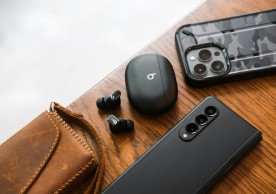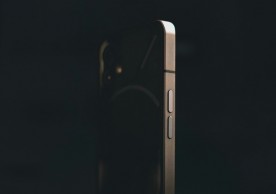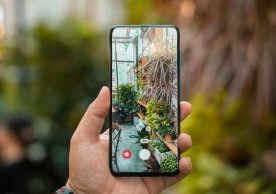Canon G7X Mark II vs Sony RX100 IV vs Panasonic LX100 Review: How These Point-And-Shoot Cameras Can Kill DSLR
Canon G7X Mark II vs Sony RX100 IV vs Panasonic LX100 Review: How These Point-And-Shoot Cameras Can Kill DSLR
C. de LacyThe competition among point-and-shoot cameras has always been a close fight between top-tier camera brands like Canon, Sony, Panasonic, and Nikon. To those who know their way well with prosumer point-and-shoots, they may even replace DSLRs.
From beginners to experts' point of view, the G7X Mark II, RX100, and LX100 are so well-equipped, they can easily take DSLRs' places.
For a clear comparison without having to strain eyes staring at photos, we'll use numerical figures from Snapsort to complete show the differences between these prosumer-level point and shoots. There are lots of differences between these cameras, but we'll save potential owners the time by pointing out the most important ones.
As we pit Canon G7X Mark II with Sony RX100 and Panasonic LX100, we'll highlight the pros, cons and a quick takeway.
Touch Screen
Canon G7X Mark II has a touch screen feature. This seems to be a standard nowadays with midrange to higher-end point and shoots. RX100 and LX100, on the other hand, doesn't have this feature. It's not a big deal breaker, but it gives Canon users a bit of leverage for getting more space for the screen and less cluttered buttons.
Flip-Out Screen
Yet not another deal-breaker, having a flip-out screen opens up more shooting possibilities. Both Canon G7X Mark II and Sony RX100 have these feature. Both their screens can be flipped by 180 degrees horizontally upwards only though. Panasonic LX100 doesn't have this feature.
Aperture and Sensor
This is where things get interesting with these three point-and-shoots. All three cameras have relatively large image sensors. With LX100 having micro 4/3s, RX100 and G7X Mark II also has large sensors in Nikon CX format. With Apertures going around f/1.7 and f/1.8, "bokeh" shots are easy to produce.
For beginners, "bokeh" is a term used for blurring out the background with the focus only on the main subject and vice versa. The larger the sensor and the smaller the aperture value is, the better this can be produced.
DSLRs have APS-C sensors which are way larger than point-and-shoots. Still, with the image produced below using the RX100, background blurring is very effective and with a bit of tweaking, it could even be better.
Video
Video is also one big factor to consider with these cameras. As with the image quality they produce, they can easily produce the same quality on videos. There are features that are even better than some entry-level to midrange DSLRs like full manual control. Watch the video below to see Canon G7X Mark II in action.
While these features and functions may be appealing for enthusiasts and beginners, point-and-shoots still would not replace DSLRs. However, if portability and features are to be taken into consideration, one might find the Canon G7X Mark II, Sony RX100 IV, or Panasonic LX100 as a very viable solution.
most read
related stories
more stories from Reviews
-
Top 5 Android Phones for Students in 2024: A Comprehensive Guide
Discover the top 5 Android phones tailored for students in 2024! Don't miss out on this comprehensive guide to find the perfect device for your academic journey.
ernest hamilton -
Samsung Galaxy S20 FE 5G vs. iPhone 13: Choosing the Best Phone for Teens
Deciding between Samsung Galaxy S20 FE 5G and iPhone 13? Find the best phone for teens with this detailed comparison.
ernest hamilton -
Coachella 2024: From Paying, to Finding Music, Here Are 5 Apps You Need For The Festival
Prepare for Coachella 2024 with these 5 must-have apps, from payment solutions to music discovery. Enhance your festival experience now!
ernest hamilton -
8 Parent-Approved Phones for Kids and Teens
Discover 8 Parent-Approved Phones for Kids and Teens! Make the right choice for your child's first smartphone. Read our guide now!
ernest hamilton -
Samsung Galaxy S24 Plus vs. iPhone 15 Plus: Clash of the Flagship Titans
Galaxy S24 Plus vs. iPhone 15 Plus: Clash of flagship titans! Explore the battle between Samsung's latest Galaxy and Apple's upcoming iPhone. Discover which reigns supreme!
ernest hamilton -
Nothing Phone 2a vs Asus Zenfone 10: Midrange Android Battle
Midrange Android showdown: Nothing Phone 2a vs Asus Zenfone 10. Discover which device reigns supreme in our in-depth comparison. Read now for the ultimate smartphone decision!
ernest hamilton -
Humane AI Pin Review: Falls Short of Being a True 'Smartphone Killer
Humane AI Pin Review: Falls short of being a true 'smartphone killer'. Dive into our comprehensive review to uncover the strengths and limitations of this intriguing device.
ernest hamilton -
Oppo Reno 11F vs Oppo Reno 11: Understanding the Differences
Exploring Oppo's latest! Oppo Reno 11F vs Oppo Reno 11: Understanding the differences. Find the perfect fit for your needs with our detailed comparison. Dive in!
ernest hamilton









